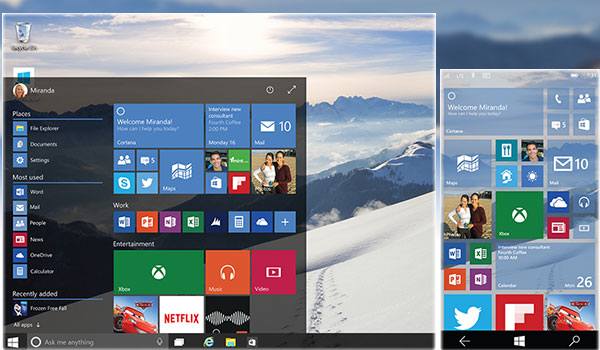Microsoft on Monday confirmed that Windows 10 will be released July 29 as a free upgrade for PCs and tablets running Windows 7 and Windows 8.1, and on new Windows 10 devices.
The OS will be available for other devices later this year. However, Microsoft hasn’t indicated which of the at least seven Windows 10 builds will be released.
Windows 10 includes the Start menu, which was brought back in Win 8.1 after its exclusion from Win 8 outraged many users.
Consumers can reserve free upgrades now.
New Features in Windows 10
Windows 10 features Microsoft’s Cortana personal digital assistant.
Cortana is integrated into Microsoft Edge, the new browser built from the ground up for Windows 10.
The new OS also includes Windows Hello, which greets users by name. It includes biometric authentication so users can log into their PCs without a password.
Windows 10 runs the full Office 2016 suite, plus new, Universal Windows applications for Word, Excel, PowerPoint and Outlook that offer a consistent, touch-first experience across a range of devices.
The OS also features Windows Continuum, which transforms desktop applications for mobile device use and vice versa, and lets Windows phones be used as PCs.
In addition, Windows 10 lets users play games on the Xbox Live gaming network using their PCs or tablets.
Caveats, Warnings and Grumbles
Users of Windows 7 and Windows 8.1 PCs and laptops have to register within one year to get the free upgrade. The Enterprise editions of these OSes don’t qualify. Users of machines running Windows Vista or XP, or pirated versions of Windows, don’t qualify either. The free upgrade is limited by the life of the device it’s installed on.
Cortana won’t be available in all markets at launch. Windows Hello will require a specialized illuminated infrared camera for facial recognition or iris detection, or a finger print reader that supports the Windows Biometric Framework. Continuum for phones will be available only on selected models at launch.
No Pain, No New Feature Gain
Getting users to purchase a new laptop or desktop in order to fully exploit the new features of Windows 10 is “absolutely the intent,” said Wes Miller, senior analyst at Directions on Microsoft.
“While an existing device is likely to work quite well with Windows 10, making the most of the new OS — if you really want to use all the new features, Windows Hello in particular — will likely require a new PC,” he told TechNewsWorld.
Still, most existing Windows applications that don’t offer low-level security or management functionality will just work on Windows 10, Miller said, although full backward compatibility remains an issue.
“Microsoft is uninstalling their own Media Center feature, even if you paid for it in the past,” he pointed out.
Kicking RT Users to the Curb
Devices running Windows RT will not be able to upgrade to Windows 10, which puzzles Al Hilwa, a research program director at IDC.
That leaves purchasers of Microsoft Surface RT and Surface 2 out in the cold.
“Since [these devices] would only run the ARM version of Windows 10, one might imagine that they would be able to run Windows 10 Mobile,” Hilwa told TechNewsWorld.
“Microsoft has decided that Surface either has unique hardware requirements that makes the machines unable to run this OS, or that the experience or testing cycle has not been adequate for such larger-screen devices.”
Just Following Industry Practices
It’s understandable that Cortana won’t be available globally when Windows 10 is launched, Miller said.
“Google and Apple have done the same in the past, as localizing an intelligent assistant isn’t easy,” he explained. “I’d expect it to arrive in other locals over the coming months and years.”
Windows 10 “will work on a pretty significant swath of existing systems out there,” Miller pointed out. While existing devices’ hardware may not be able to exploit new features in the OS, “this is often the case when a new OS ships.”























































